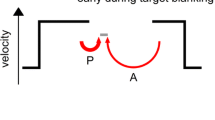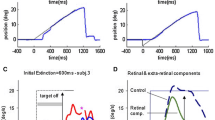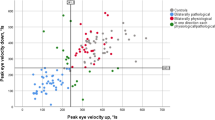Abstract
Changes in smooth pursuit eye tracking of horizontal sinusoidal target movement before and after up to 10 mg oral diazepam were measured electrooculographically in diazepam-naive humans. Diazepam produced a dose-dependent reduction in gain of pursuit eye movements at target frequencies of 0.4–1.6 Hz. Cross-correlation of eye and track was significantly reduced at most frequencies showing gain reduction after 10 mg diazepam. Eye-target phase relationship was not systematically altered by drug. Visual inspection of smooth pursuit tracking records showed reduced peak-to-peak amplitude of eye tracking along with replacement of smooth pursuit with saccadic pursuit, especially after 10 mg. Changes in smooth pursuit eye tracking after diazepam were similar to those changes reported in the literature associated with olivopontocerebellar atrophy and were quite unlike the changes in smooth pursuit after opiates, as previously reported. The role of cerebellar benzodiazepine binding sites in diazepam disruption of eye tracking was discussed.
Similar content being viewed by others
References
Aho AV, Hopcraft JE, Ullman JD (1974) The design and analysis of computer algorithms. Addison Wesley, Massachusetts
Armor DJ, Couch AS (1972) Data-text primer. Free Press, New York
Aschoff JC (1968) Veränderungen rascher Blickbewegungen (Saccaden) beim Menschen unter Diazepam. Arch Psychiatr Nervenkr 211:325–332
Aschoff JC, Becker W (1973) Computer-electronystagmography in evaluating the influence of psycho-pharmacological drugs on vigilance. AGARD (Advisory Group for Aerospace Research and Development) pre-print No. 128 NATO
Aschoff JC, Becker W, Weinert D (1975) Computer analysis of eye movements: Evaluation of the state of alertness and vigilance after sulpiride medication. J Pharmacol Clin 11:93–97
Avanzini G, Girotti F, Crenna P, Negri S (1979) Alterations of ocular motility in cerebellar pathology: An electrooculographic study. Arch Neurol 36:274–280
Baloh RW, Konrad HR, Honrubia V (1975) Vestibulo-ocular function in patients with cerebellar atrophy. Neurology 25:160–168
Brown JR (1975) Diseases of the cerebellum. In: Baker AB, Baker LH (eds) Clinical neurology. Vol 2. Harper and Row, Hagerstown, pp 1–38
Drischel H (1968) The frequency response of horizontal pursuit movements of the human eye and the influence of alcohol. Prog Brain Res 22:161–174
Flom MC, Brown B, Adams AJ, Jones RT (1976) Alcohol and marijuana effects on ocular tracking. Am J Optom Physiol Opt 53:764–773
Gentles W, Thomas EL (1971) Effect of benzodiazepines upon saccadic eye movements in man. Clin Pharmacol Ther 12:563–574
Guedry FE, Gilson RD, Schroeder DJ, Collins WE (1975) Some effects of alcohol on various aspects of oculomotor control. Aviat Space Environ Med 46:1008–1013
Jürgens R, Becker W, Kornhuber HH (1979) Evidence for local feed back in the generation of saccadic eye movements. Pflügers Arch 382:40
Kase M, Noda H, Suzuki DA, Miller DC (1979) Target velocity signals of visual tracking in vermal purkinje cells of the monkey. Science 205:717–720
Königsmark BW, Weiner LP (1970) The olivopontocerebellar atrophies: A review. Medicine 49:227–240
Möhler H, Okada T (1978) Biochemical identification of the site of action of benzodiazepines in human brain by 3H-diazepam binding. Life Sci 22:985–996
Noda H, Suzuki DA (1979) The role of the flocculus of the monkey in fixation and smooth pursuit eye movements. J Physiol (Lond) 294:335–348
Rothenberg SJ, Selkoe D (1981) Specific oculomotor deficit after diazepam: Saccadic eye movements. Psychopharmacology 74: 232–236
Rothenberg S, Schottenfeld S, Selkoe D, Gross K (1980a) Specific oculomotor deficit after acute methadone. II. Smooth pursuit eye movements. Psychopharmacology 67:229–234
Rothenberg S, Schottenfeld S, Gross K, Selkoe D (1980b) Specific oculomotor deficit after acute methadone. I. Saccadic eye movements. Psychopharmacology 67:221–227
Speth RC, Wastek GJ, Johnson PC, Yamamura HI (1978) Benzodiazepine binding in human brain: Characterization using (3H)flunitrazepam. Life Sci 22:859–866
Stern JA, Bremer DA, McClure J (1974) Analysis of eye movements and blinks during reading: Effects of valium. Psychopharmacologia 40:171–175
Wilkinson IMS, Kime R, Purnell M (1974) Alcohol and human eye movement. Brain 97:785–792
Young WS, Palacios JM, Kuhar MJ (1980) Histochemistry of receptors. Adv Biochem Psychopharmacol 21:51–56
Author information
Authors and Affiliations
Rights and permissions
About this article
Cite this article
Rothenberg, S.J., Selkoe, D. Specific oculomotor deficit after diazepam. Psychopharmacology 74, 237–240 (1981). https://doi.org/10.1007/BF00427101
Received:
Accepted:
Issue Date:
DOI: https://doi.org/10.1007/BF00427101




